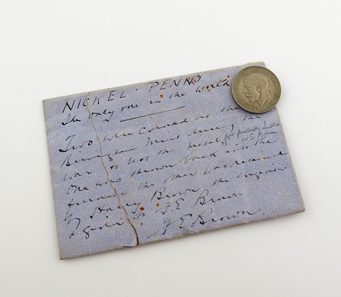21-10-2013 – 22-10-2013
Silver sale
Unique Coin goes to Aston Martin ‘DB’
Featuring in the Silver sale at Woolley and Wallis Salisbury Salerooms are two lots of interest: The first is an unpublished 1919 KN Penny struck in cupro-nickel George V, Penny, 1919 KN [King’s Norton], struck in cupro-nickel (cf BMC [Peck] 2257; cf S 4053). A soft strike with slight ‘ghosting’ on the reverse, nearly extremely fine.
The coin, the existence of which has never been published, has an interesting history and provenance going all the way back to 1919. Following the Great War, the Royal Mint in London did not have the capacity to strike bronze pennies and for the two years, 1918 and 1919, they sub-contracted the work to the King’s Norton Metal Company, near Birmingham, all of whose coins were clearly identified with a KN ‘mint mark’. The coin was examined by The Royal Mint in 2000 and they confirm it to be genuine, the specifications of the metal being the same as that of the British West Africa Penny (though that coin when struck had a hole in its centre). The BWA Penny was being manufactured at the nearby Birmingham Mint and at some point a blank found its way to King’s Norton and the coin now offered for sale was struck.
A letter in the hand of one F. E. Brown (and in an envelope with his B monogram), sold with the lot reads ‘Nickel Penny / The only one in the world. Two were coined at the Birmingham Mint (sic) during the war to test the metal for probably India or South Africa. One was thrown back into the furnace, the other was retained by Harry Brown the engineer and given to F. E. Brown.’
Francis Edward Brown (1873-1941), was the son of the founder of the manufacturing company David Brown Ltd, and was an industrialist of considerable local importance (the coin is sold together with a travelling case – the bottles in which are all engraved with the B monogram). On his death the chairmanship of the company passed to his son David Brown (1904-1993), who perhaps is best remembered for lending his initials ‘DB’ to Aston Martin cars – which were a part of the company, previously better known for its tractors.
It seems the Penny was kept amongst old paper-work and it passed to F. E. Brown’s widow Carrie who died in 1949, then to their son David. In 1955 the travelling case (with the coin inside) was retained by David Brown’s wife, Daisie, whom he was divorcing. In turn she gave it to her chauffeur / butler, Veroslav (Vern) Houska, father of the vendor.
Considerable research has been carried out by the vendor and copies of the paperwork are included in the lot.
The lot will be auctioned on the 22nd October with an estimate of £2,000 – £2,500.
The other lot which again combines rarity with quantity is a collection of Italian bank notes. Following a Decree signed in September 1745 the Regie Finanze-Torino [Royal Treasury] approved the first ever issue of banknotes in Italy, to the value of 4,000,000-Lire. The issue of notes would help establish Turin as a financial centre and thereby increase its status as a capital city. When signed and numbered the left hand portion would be cut with a wavy line and this counterfoil retained in a book so that on redemption each note could be verified as genuine. In 1746 a 100-Lire note was of substantial value; there were 6-Lire to a Scudo, a silver crown-sized coin and each Lira was worth 20-Soldi or 100-Centesimi. The Lira was a currency unit that was later adopted by all Italian States and indeed the Kingdom of Italy until 1871.
This hoard of uncut, unsigned and un-numbered notes is remainders from the original printing of 1746. They were discovered some 20 years ago in Switzerland to where, it seems, the family of the original printing house had moved many years previously.
We’re selling four lots, with 50 notes in each, each lot with an estimate of £2,200 – £2,600.
A fully illustrated catalogue is available online.







